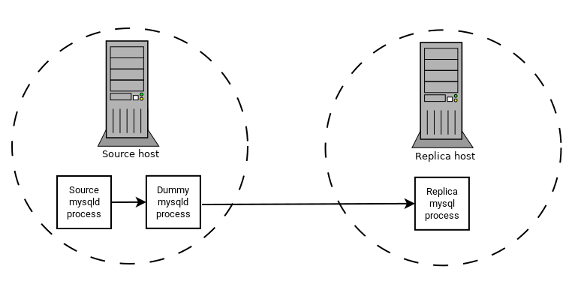The BLACKHOLE storage engine acts as a
“black hole” that accepts data but throws it away and
does not store it. Retrievals always return an empty result:
mysql> CREATE TABLE test(i INT, c CHAR(10)) ENGINE = BLACKHOLE;
Query OK, 0 rows affected (0.03 sec)
mysql> INSERT INTO test VALUES(1,'record one'),(2,'record two');
Query OK, 2 rows affected (0.00 sec)
Records: 2 Duplicates: 0 Warnings: 0
mysql> SELECT * FROM test;
Empty set (0.00 sec)
To enable the BLACKHOLE storage engine if you
build MySQL from source, invoke CMake with the
-DWITH_BLACKHOLE_STORAGE_ENGINE
option.
To examine the source for the BLACKHOLE engine,
look in the sql directory of a MySQL source
distribution.
When you create a BLACKHOLE table, the server
creates the table definition in the global data dictionary. There
are no files associated with the table.
The BLACKHOLE storage engine supports all kinds
of indexes. That is, you can include index declarations in the table
definition.
The maximum key length is 3072 bytes.
The BLACKHOLE storage engine does not support
partitioning.
You can check whether the BLACKHOLE storage
engine is available with the SHOW
ENGINES statement.
Inserts into a BLACKHOLE table do not store any
data, but if statement based binary logging is enabled, the SQL
statements are logged and replicated to replica servers. This can be
useful as a repeater or filter mechanism.
Suppose that your application requires replica-side filtering rules,
but transferring all binary log data to the replica first results in
too much traffic. In such a case, it is possible to set up on the
replication source server a “dummy” replica process
whose default storage engine is BLACKHOLE,
depicted as follows:
The source writes to its binary log. The “dummy”
mysqld process acts as a replica, applying the
desired combination of replicate-do-* and
replicate-ignore-* rules, and writes a new,
filtered binary log of its own. (See
Section 19.1.6, “Replication and Binary Logging Options and Variables”.) This filtered log is
provided to the replica.
The dummy process does not actually store any data, so there is little processing overhead incurred by running the additional mysqld process on the replication source server. This type of setup can be repeated with additional replicas.
INSERT triggers for
BLACKHOLE tables work as expected. However,
because the BLACKHOLE table does not actually
store any data, UPDATE and
DELETE triggers are not activated:
The FOR EACH ROW clause in the trigger definition
does not apply because there are no rows.
Other possible uses for the BLACKHOLE storage
engine include:
Verification of dump file syntax.
Measurement of the overhead from binary logging, by comparing performance using
BLACKHOLEwith and without binary logging enabled.BLACKHOLEis essentially a “no-op” storage engine, so it could be used for finding performance bottlenecks not related to the storage engine itself.
The BLACKHOLE engine is transaction-aware, in the
sense that committed transactions are written to the binary log and
rolled-back transactions are not.
Blackhole Engine and Auto Increment Columns
The BLACKHOLE engine is a no-op engine. Any
operations performed on a table using BLACKHOLE
have no effect. This should be borne in mind when considering the
behavior of primary key columns that auto increment. The engine does
not automatically increment field values, and does not retain auto
increment field state. This has important implications in
replication.
Consider the following replication scenario where all three of the following conditions apply:
On a source server there is a blackhole table with an auto increment field that is a primary key.
On a replica the same table exists but using the MyISAM engine.
Inserts are performed into the source's table without explicitly setting the auto increment value in the
INSERTstatement itself or through using aSET INSERT_IDstatement.
In this scenario replication fails with a duplicate entry error on the primary key column.
In statement based replication, the value of
INSERT_ID in the context event is always the
same. Replication therefore fails due to trying insert a row with a
duplicate value for a primary key column.
In row based replication, the value that the engine returns for the row always be the same for each insert. This results in the replica attempting to replay two insert log entries using the same value for the primary key column, and so replication fails.
Column Filtering
When using row-based replication,
(binlog_format=ROW), a replica
where the last columns are missing from a table is supported, as
described in the section
Section 19.5.1.9, “Replication with Differing Table Definitions on Source and Replica”.
This filtering works on the replica side, that is, the columns are copied to the replica before they are filtered out. There are at least two cases where it is not desirable to copy the columns to the replica:
If the data is confidential, so the replica server should not have access to it.
If the source has many replicas, filtering before sending to the replicas may reduce network traffic.
Source column filtering can be achieved using the
BLACKHOLE engine. This is carried out in a way
similar to how source table filtering is achieved - by using the
BLACKHOLE engine and the
--replicate-do-table or
--replicate-ignore-table option.
The setup for the source is:
CREATE TABLE t1 (public_col_1, ..., public_col_N,
secret_col_1, ..., secret_col_M) ENGINE=MyISAM;The setup for the trusted replica is:
CREATE TABLE t1 (public_col_1, ..., public_col_N) ENGINE=BLACKHOLE;The setup for the untrusted replica is:
CREATE TABLE t1 (public_col_1, ..., public_col_N) ENGINE=MyISAM;